 Weird Stuff
Weird Stuff  Weird Stuff
Weird Stuff  Animals
Animals 10 Inspiring Tales of Horses Being Human
 Mysteries
Mysteries Top 10 Haunting Facts About the Ghost Ship MV Alta
 History
History 10 Surprising Stories About the Texas Rangers
 Humans
Humans 10 Philosophers Who Were Driven Mad by Their Own Theories
 Miscellaneous
Miscellaneous 10 Video-Game-Worthy Weapons and Armors from History
 Weird Stuff
Weird Stuff 10 Psychics Who Accurately Predicted Wartime Events
 The Arts
The Arts 10 Pieces of Art Inspired by a Broken Heart
 Health
Health 10 Science Fiction-Sounding New Medical Treatments
 History
History 10 Surprising Facts About the Father of Submarine Warfare
 Weird Stuff
Weird Stuff 10 Times Real Laws Were Based on Bizarre Hypotheticals
 Animals
Animals 10 Inspiring Tales of Horses Being Human
 Mysteries
Mysteries Top 10 Haunting Facts About the Ghost Ship MV Alta
Who's Behind Listverse?

Jamie Frater
Head Editor
Jamie founded Listverse due to an insatiable desire to share fascinating, obscure, and bizarre facts. He has been a guest speaker on numerous national radio and television stations and is a five time published author.
More About Us History
History 10 Surprising Stories About the Texas Rangers
 Humans
Humans 10 Philosophers Who Were Driven Mad by Their Own Theories
 Miscellaneous
Miscellaneous 10 Video-Game-Worthy Weapons and Armors from History
 Weird Stuff
Weird Stuff 10 Psychics Who Accurately Predicted Wartime Events
 The Arts
The Arts 10 Pieces of Art Inspired by a Broken Heart
 Health
Health 10 Science Fiction-Sounding New Medical Treatments
 History
History 10 Surprising Facts About the Father of Submarine Warfare
Top 10 Bizarre Natural Phenomena In Everyday Foods
When thinking about extraordinary foods, most minds would conjure up images of obscure cuisine, and elaborate dishes with unpronounceable names. However, remarkable secrets lie hidden in foods we eat on a daily basis, with fascinating scientific explanations behind them. From nuts to fruits, to vegetables, here are 10 Bizarre Natural Phenomena in Everyday Foods.
10 Foods That Have Been Genetically Modified Beyond Recognition
10 Brazil Nuts
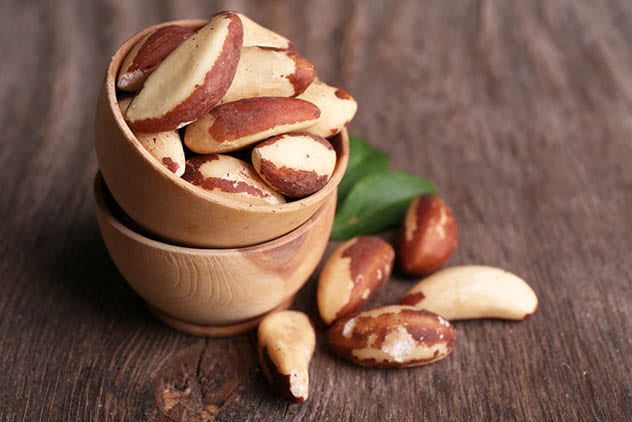
Anyone who has ever had a container of nuts has unknowingly witnessed a strange effect that no scientist has been able to fully explain. In nearly every package of nuts, the Brazil nuts will appear at the top, with the smaller nuts at the bottom. The same applies to cereal, with all the largest cereal at the top of the box and nothing but dusty shreds all the way at the bottom. But why? Common knowledge tells us that larger nuts would sink to the bottom, with smaller nuts rising to the top. Well, nobody quite knows. Dubbed the “Brazil Nut Effect” but more professionally known as “granular convection,” this phenomena has stumped experts for years. The concept refers to when various pieces of small, similar mass objects rotate in a way similar to how fluids move.[2] The process a package of nuts goes through to get from the factory to the hands of a consumer requires lots of jostling.
When the nuts are all pushed upward, the smaller ones will fall below the larger ones, pushing them upward. This will repeat in a cycle because the nuts are continuously shaken around. However, the Brazil Nut Effect provides a slight wrinkle to this logic. See, the Brazil nuts will reach the top of the container and just stay there, thus ending the cycle. Scientists aren’t sure why they aren’t able to move from their position on top. Of course, many theories have been presented. Perhaps the nuts are too big to fit into any smaller spaces in the container after that shake, or perhaps the density of the nuts play a role in pushing it towards the surface. Either way, the science has applications beyond this nutty predicament (get it)? Dr. Douglas J. Jerolmack and his team have even found a link between this phenomenon and the reason why rivers can resist erosion, because rivers too have larger rocks near the top with sand and gravel further down in the river.[2]
9 Cranberries
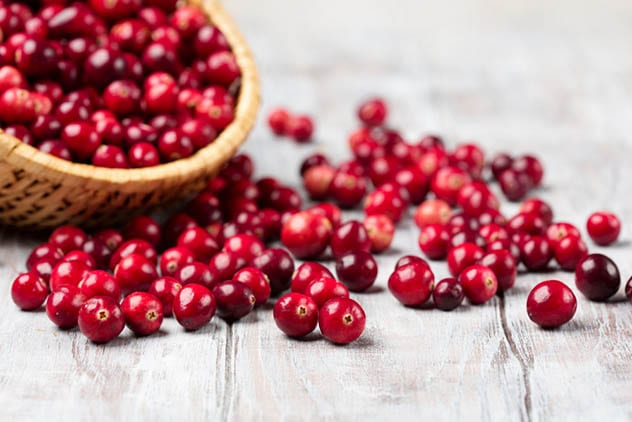
Nobody would think to compare an ordinary cranberry with a popular children’s toy, but there is a surprising similarity between the two. Though commonly cooked and softened in order to reduce the natural tartness of the fruit, a raw cranberry has a very different texture. When ripe, it will be able to bounce in the same fashion as a bouncy ball. This is due to the small air pockets inside of each cranberry, as well as the firm texture that allows it to bounce up off the ground. In fact, cranberry farmers even use this as a ripeness test for their berries. It is common for berry farmers to bounce each cranberry over a wooden barrier, where the berries that clear the barrier will go into circulation, while the ones that don’t, go into separate bins to become juice. Interestingly, this was discovered by accident, when an old farmer from New Jersey known as John “Peg Leg” Webb poured his supply of cranberries down the stairs. Due to his wooden leg, this was his best method of transporting them. However, he noticed that the more firm cranberries would bounce to the bottom, while the softer and more battered berries would sit limply at the top of the staircase. This discovery took place in 1880, and farmers have been using bounciness to test cranberry ripeness ever since.[3]
8 Corn
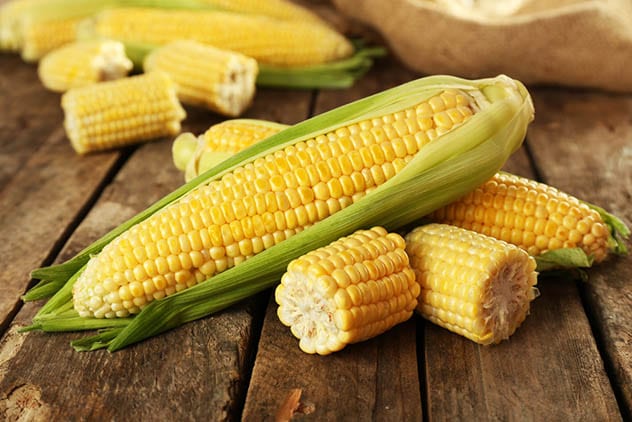
Corn has been around for thousands of years, yet few realize that every ear of corn has a unique similarity about it. See, corn will always have an even number of rows. This is due to the fact that a corn ear is not just a vegetable, but an inflorescence, meaning that it produces nearly 1000 female flowers. These flowers, otherwise known as the future kernels, will be ordered into rows, forming the common image of an ear of corn. An average ear of corn has 800 kernels, organized into 16 rows. The even number comes from the fact that each spikelet (basic grass flower) will produce two florets, which are the small flowers that make up a full flower head. It will produce two because one floret must be fertile while the other must be sterile. Interestingly, this applies to foods other than corn. Watermelon, for example, supposedly has a consistently even number of stripes. No matter the case, this stems (no pun intended) from the fact that a cell will always divide into two cells that in turn each divide into two more cells. As this cycle continues, the number will always stay even. How odd![4]
7 Pistachios
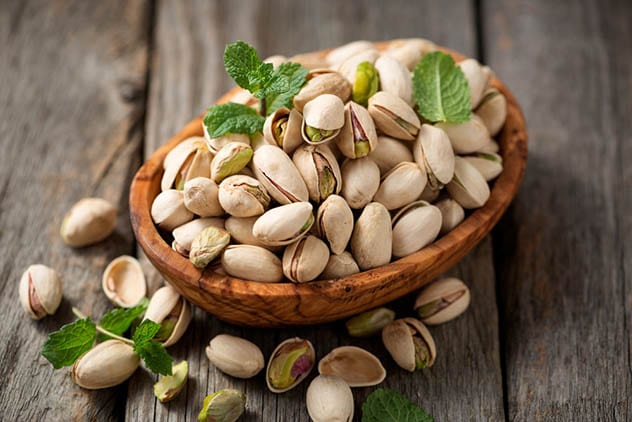
Pistachios may seem innocent enough, but little did we know that they have a sinister side. That’s because pistachios, when stored in large quantities, are at high risk of spontaneously combusting. It is a known fact that fat burns very easily, and each pistachio nut is nearly 50% fat. Furthermore, pistachios have almost no water in them, and if they are kept in a high-moisture area, then they become moldy. With their total absence of water and a high concentration of fat, pistachios are at risk of becoming flammable. This risk turns into reality when pistachios are packed close together in large amounts, as the oils of the nuts can heat themselves up, causing them to burst into flames. Because they can self-heat, this pistachio-fueled nightmare can occur with no warning, with no human contact. This has led to many strict guidelines as to how pistachios are shipped, as most of the world pistachio production comes from the Middle East. This means that ships are required for transport, and nobody wants to see a boat burn down from improperly packaged nuts.[5]
6 Nutmeg
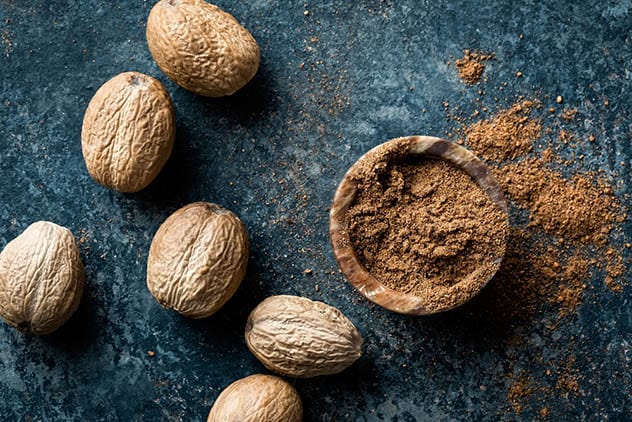
Nutmeg is a spice most commonly used around the holidays, as a sweet garnish to drinks or an ingredient in desserts. However, just like the pistachio, there is a dark secret behind this festive spice. This is because nutmeg is really a hallucinogen, capable of causing powerful highs and unpleasant side effects. Sudden bursts of panic, trouble urinating, and constantly dry mouth are just a few consequences of the hallucinogenic trip. Nutmeg itself is actually a seed, and it contains a compound known as myristicin. Myristicin is used in many drugs that are used to affect mental state, and it is the reason why nutmeg produces hallucinogenic effects.
Though this may shock all of us, it wouldn’t have surprised anyone in 12th century Europe. Back then, it was considered a drug rather than a garnish, and people would use it frequently in order to induce hallucinations. It is even believed that famous physician Nostradamus ingested nutmeg in order to gain visions that led to his scientific discoveries. Nutmeg remained a popular drug for years to come, but somewhere along the way its status shifted into the innocent spice, we know it as today.[6]
10 Bizarre Origin Stories About Your Favorite Foods
5 Mushrooms
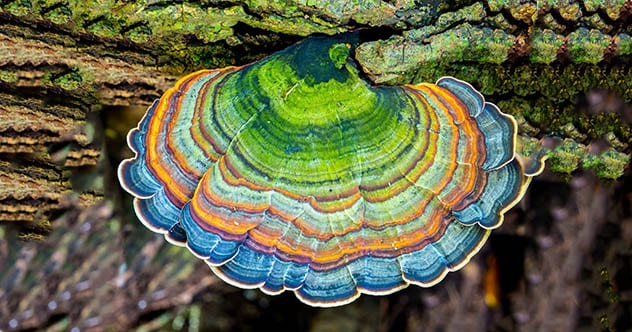
There is often a fine line between a food being undercooked, overcooked or cooked to perfection. Luckily, for those of us who can’t easily navigate this line, there is one risk-free ingredient that we can use: The mushroom. You see, it is close to impossible to overcook a mushroom because their cell walls have a different molecular structure than that of meat or vegetables. While the cell walls in meat and vegetables contain protein and pectin respectively, the mushroom contains a polymer called chitin. Chitin is extremely heat stable, which means that when it is cooked, the heat has little effect on the molecular structure of the mushroom. This is different than meats and other veggies, because heat causes proteins in the meat to tense up (causing overcooked meat to be chewy) and it causes pectins in vegetable cells to break down; resulting in a mushy clump of green.
In an attempt to scientifically prove this phenomenon, Dan Souza, the executive editor of America’s Test Kitchen put mushrooms to the test once and for all. Souza took a mushroom, a piece of zucchini, and a hunk of beef tenderloin, and steamed them all for forty minutes. Every five minutes he put each item through a texture analysis that calculated the amount of force that would be required to bite into the said item. Not very surprisingly, the mushroom outperformed its competitors by remaining within 100 grams of force to bite into throughout the whole testing period. In comparison, the tenderloin shot up 500 grams of force and the zucchini went down almost 200. In other words, the mushroom remained texturally consistent while the tenderloin became tough and the zucchini became limp and chewy.[7]
4 Chili Peppers
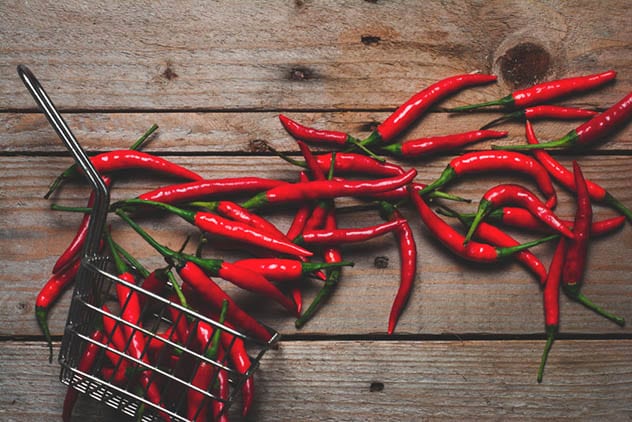
With a quarter of the world’s population eating chili peppers on a daily basis, it is clear that many people enjoy the jolt of spiciness that has become the trademark of these peppers. While people around the world have chosen to embrace the chili pepper and feel the burn, few people have stopped to wonder the cause of this sensation in the first place. All chili peppers contain an active ingredient called capsaicin, which activates the heat-sensing protein in our brains when bitten into. When the protein senses heat, it causes the brain to send a shot of burning pain to the pepper eater. This means that peppers are tricking our brains into feeling a burning sensation since we will not actually be burned from eating a pepper. Scientists have determined that pepper plants actually evolved this way in order to keep predators from eating their fruit. Interestingly, birds do not feel any burn when eating peppers, and peppers actually evolved this way on purpose. This is because unlike mammals, birds eat pepper seeds whole, so when they excrete these seeds, they spread the pepper plant and ensure its survival.[8]
3 Rhubarb
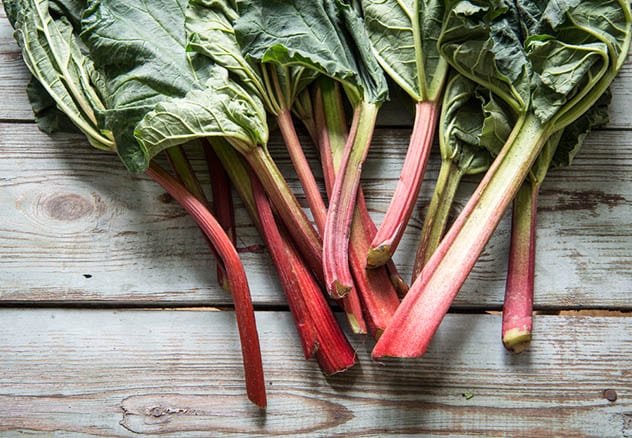
The rhubarb is a perennial plant that is similar to celery, but it is commonly classified as a fruit due to its sour and fruity taste. Stuck in between these two categories, the rhubarb seems to be somewhat ignored in society, with the more traditional apple or broccoli thrust into the limelight. However, there is a unique phenomenon that occurs with the humble rhubarb plant, and it has to do with the way that it is grown. You see, since the 1800s, rhubarb farmers have harvested these veggie/fruits in a method called “forced rhubarb.” In this method, rhubarbs are grown in the dark, which causes them to mature at an alarmingly rapid rate. When rhubarbs grow this fast, it causes them to make a loud popping noise as they burst out of their initial buds and begin to grow upward. As they continue to rise, they begin to rub against other rhubarb stalks, which creates an interesting squeaking and creaking noise. Rhubarb farmer Brian French says about the noise, “I have heard the noise before. Growing against each other. You really have to listen for it.” The reason behind this musical method of rhubarb growing is that the dark room makes rhubarb plants unable to photosynthesize, which results in a less stringy and more tender rhubarb. You can listen to the sound of rhubarb growing here.[9]
2 Cashews
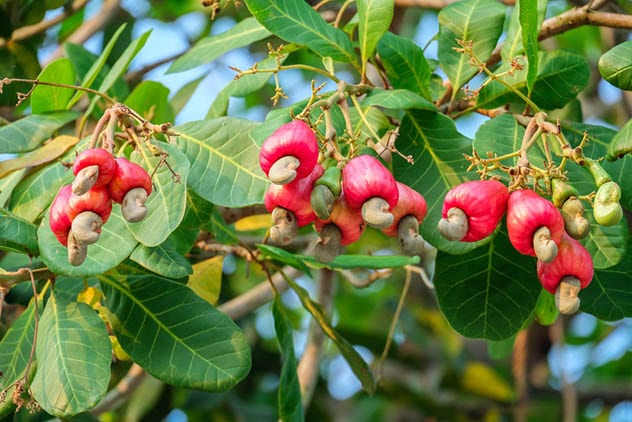
Of all the nuts on this list, cashews have perhaps the strangest trait of all. When asked what grows on a cashew tree, most would probably assume that it would be, well, cashews. Though that is correct, the nut is actually not the primary fruit of a cashew tree. Native to the coastal areas of northern Brazil, cashew trees actually grow apples. The actual nuts sprout from the bottom of each apple. Most of us have likely never heard of a cashew apple, or seen them being sold anywhere. This is because, though they are perfectly safe, the thick skin of cashew apples make them difficult to transport. Cashew apples don’t go to waste though; the pulp is frequently used in juices and other apple-related foods. Even more surprising is the fact that the cashew “nut” is technically not a nut at all, but a seed. The cashew seed is covered by many highly toxic layers in order to scare animals away. Don’t panic, though, because only the shell is toxic. Any pack of cashews bought from a store will not have the shell, thus making them perfectly safe for consumption.[10]
1 Carrots
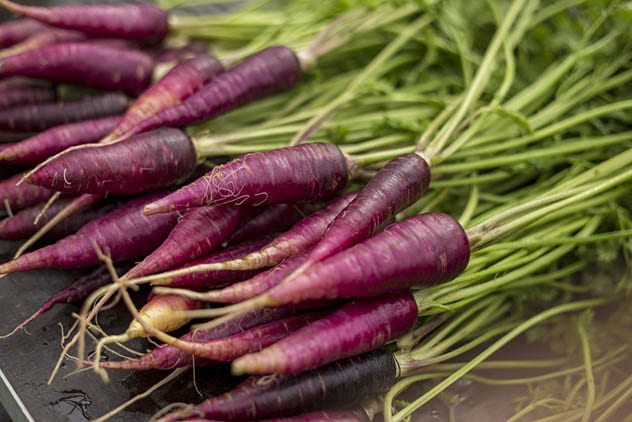
Carrots have become almost synonymous with the color orange, but carrots did not always have this distinctive hue. Originally, carrots were actually purple, but a mutant gene spread among these plants led to the creation of the yellow carrot. The transition from the harvesting of purple and yellow carrots to orange carrots is a bizarre and interesting tale. The origin of orange carrots began in the town of Arausio in Southern France. The classical pronunciation of this town was “Aurenja”, and with the French word for orange being naranj, the citizens of Arausio eventually changed the town’s name to Orange. A man named William The Silent gained rule over Orange in 1544 and was from then on known as William The Orange. After gaining rule of Arausio, William The Orange went on to lead the Dutch to their independence from Spain, thus creating the Dutch Republic.
At the same time as this revolution, another revolution was taking place. A carrot revolution. Around the time of the Dutch independence, a carrot breed was created by Dutch carrot farmers that contained a plant pigment called beta-carotene. This pigment caused an orange color in the carrot, and the Danish people began mass producing it in honor of their hero William The Orange. It got to the point where the other colors of carrots became no longer convenient to grow, which led us to the orange carrot that we know and love.[11]
10 Fruits, Nuts, And Vegetables You Did Not Know Were Man-Made








